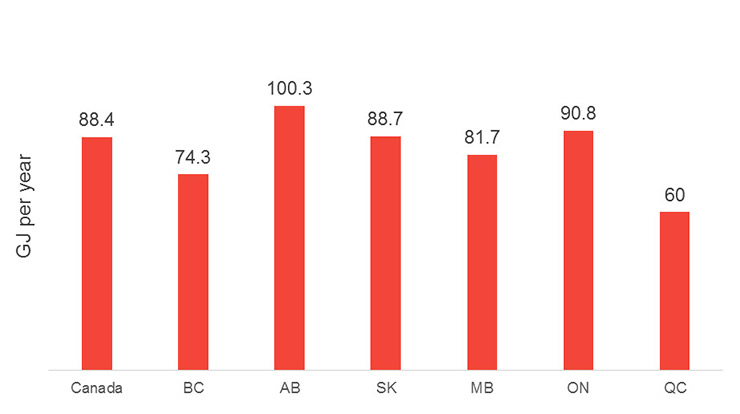What is in a Canadian residential natural gas bill?
Introduction to natural gas use

Natural gas provides energy that millions of Canadians rely on. The main residential use of natural gas in Canada is for space heating and heating water. Some homes also use small amounts of gas for cooking.
Where is natural gas used?
Gas consumption differs across Canada. Natural gas is the main source of energy for home heating in western Canada and Ontario. These provinces have access to large amounts of natural gas supply through well-developed gas pipeline systems. Ontario was connected to western Canadian gas supply by the TransCanada pipeline in 1958 and has been a major way to heat homes since then.
In contrast, only a few households in Quebec, New Brunswick, and Nova Scotia use natural gas for home heating. Quebec produces a large amount of low cost hydroelectricity, reducing the need for natural gas for home heating in the province. Nova Scotia and New Brunswick had no gas supply for their markets until late 1999, when Nova Scotia’s Sable Island offshore gas field began production and the Maritimes and Northeast Pipeline was commissioned. Homes in Prince Edward Island, and Newfoundland and Labrador do not use natural gas heating at all. In these provinces, electricity, heating oil, and wood are the most common sources of home heating.
Communities in Yukon, Northwest Territories, and Nunavut do not use residential natural gas heating. One exception is Inuvik in the Northwest Territories which has limited residential gas use. However, the two gas wells supplying the town are depleting and the town now trucks in propane and liquefied natural gas. Another exception was Norman Wells, which used gas produced at a nearby oil field until the end of 2014. After 2014, gas production fell too low to supply gas to both the town and oil field operations.
In the Northern Territories a majority of households use oil furnaces for home heating. Specific heating system data for the North is unavailable.
Figure 1: Energy source used for heating – primary heating systen by Province
Source: Statcan, CANSIM 153-0161
Note: Data for the Northern Territories is not available
Description:
On this map, each province has a pie graph depicting the four different types (in per cent) of energy used by primary heating systems reported by households in the province. "Electricity" is coloured blue; "Natural gas" is coloured red; "Heating oil" is coloured brown; and "Wood" is coloured green. The data is for the year 2015, except for NB and NS which have 2013 data.
In British Columbia (B.C.), 39% of households used electricity for their primary heating system, 58% used natural gas, 3% used oil.
In Alberta, 17% of households used electricity for their primary heating system, 79% used natural gas.
In Saskatchewan, 28% of households used electricity for their primary heating system, 72% used natural gas.
In Manitoba, 49% of households used electricity for their primary heating system, 51% used natural gas.
In Ontario, 31% of households used electricity for their primary heating system, 67% used natural gas, 4% used oil.
In Quebec, 92% of households used electricity for their primary heating system, 6% used natural gas, 2% used oil.
In New Brunswick in 2013, 60% of households used electricity for their primary heating system, 2% used natural gas, 14% used oil and 16% used wood or wood pellets.
In Nova Scotia in 2013, 35% of households used electricity for their primary heating system, 1% used natural gas, 47% used oil and 12% used wood or wood pellets.
In Prince Edward Island, 37% of households used electricity for their primary heating system, 63% used oil.
In Newfoundland and Labrador, 78% of households used electricity for their primary heating system, 22% used oil.
What affects the amount of natural gas homes use?

Not all homes in Canada use natural gas, but for those that do, average use is 88.4 gigajoules (GJ) per year. The province with the highest household use is Alberta, where average use is 100.3 GJ per year.
Many factors affect how much natural gas is used. Homes burn more gas during years with longer or colder winters. The larger or less insulated the home, and the less efficient the furnace, the more gas a home will use. Homes generally use the most natural gas in the winter and the least in the summer. Total natural gas demand can increase in the summer compared to spring or fall. This is because electricity generation from natural gas can increase because of summer air conditioning use. However, at the residential level, natural gas use is usually the lowest in the summer.
Figure 2: Canadian household natural gas consumption in 2015

Source: Statcan
Note: Data for the Maritime Provinces and the Northern Territories are not available
Description:
This column chart displays average natural gas consumption per household per month in GJ for homes that use natural gas. The chart illustrates the following:
Canadian average: 88.4; BC: 74.3; AB: 100.3; SK: 88.7; MB: 81.7; ON: 90.8; QC: 60.
- Date modified:
